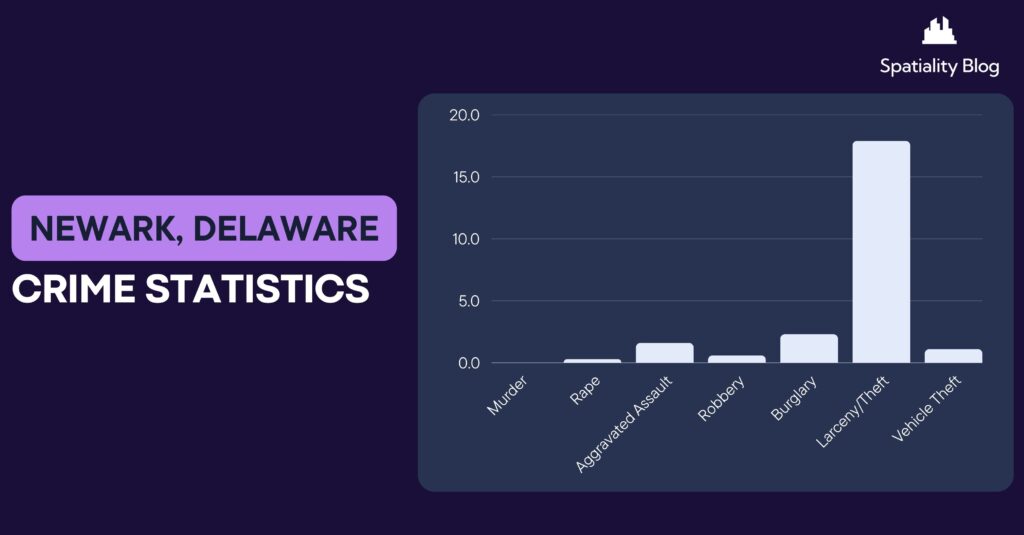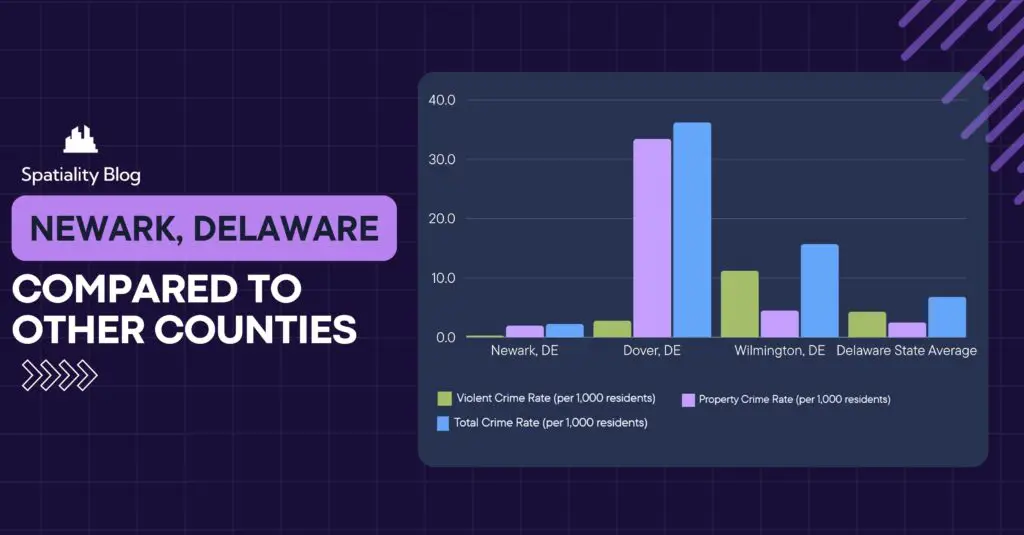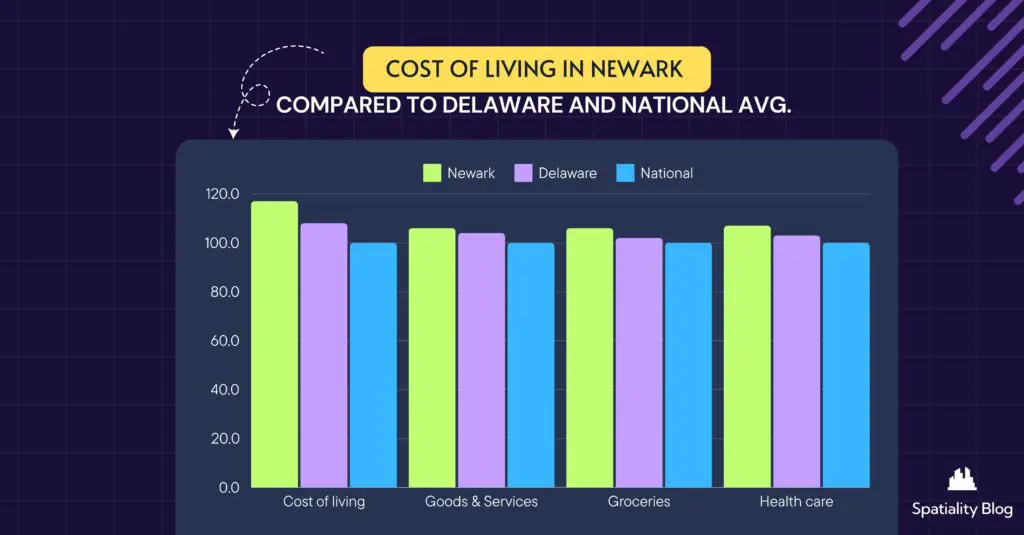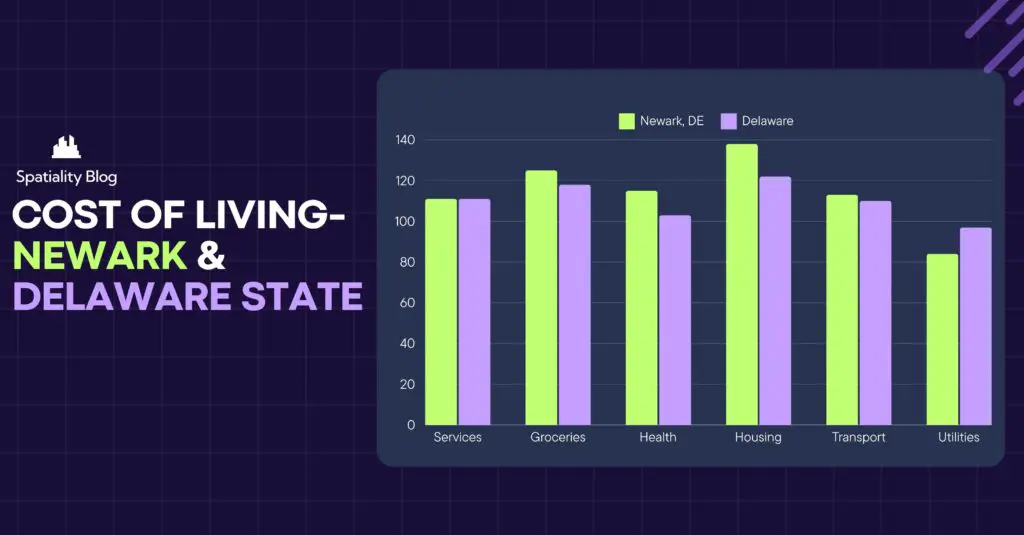“Everybody needs a safe space, and it should be their home.” Newark, Delaware, might just be that for your family. Imagine a place where you can walk around anytime without a care in the world. That’s Newark, with its low crime rates and super friendly environment!
Newark mixes old-school charm with modern living. It’s rich in history and people, and is home to the University of Delaware.
The community is active and friendly. There are regular events and neighborhood watch programs where everyone looks out for each other. It’s a place where you know your neighbors and feel part of something special.
In Newark, safety is more than a promise; it’s a way of life. With its mix of security, community spirit, and modern perks, Newark is the perfect place to call home. Don’t trust me? You do not have to take my word for it. Find it yourself.
1. What are the Crime rates in Newark Delaware?
While Newark offers many attractions and a vibrant community, understanding the local crime rates can help you stay informed and safe. It can make living in Delaware Newark a much more enjoyable experience for you.
Whether you’re exploring downtown, enjoying a meal at Iron Hill Brewery, or hiking in White Clay Creek State Park, being mindful of your surroundings and securing your property can contribute to a safer experience in the city.
The safest neighborhoods in Newark include North Star, Yorktown, Covered Bridge Farms, Salem Woods, and Four Seasons.
Newark, DE, enjoys relatively low crime rates compared to the US average. Crime is ranked on a scale from 1 (low) to 100 (high), underscoring Newark’s favorable position in both violent and property crime metrics.
1.1 Let’s talk about Violent and Property Crimes in Delaware
Property crime in Newark is also lower than the national average, with a rate of 33.0 compared to the U.S. average of 35.4. Property crimes include burglary, larceny-theft, motor vehicle theft, and arson. The city’s violent crime rate stands at 17.1, significantly lower than the U.S. average of 22.7. These statistics indicate that Newark is generally a safe city. However, residents should still stay vigilant and aware of their surroundings to prevent crime.
Crime rates per 1000 residents are also comparatively lower with about 2.5 violent crimes as against 6.8 in Delaware and 6.8 being the national average. There were 21.2 property crimes in Newark per 1000 residents as compared to 32.4 in Delaware, and 23.3 in the US. Over the decades, the violent crime rate in the U.S. has decreased significantly due to various factors such as an aging population and increased incarceration.
1.1.1 Detailed Crime Statistics:

Notably, while the violent crime rate per 100,000 residents in Delaware has come down from 684.4 in the year 2000 to 422.6 in 2019, the same in Newark has come down from 462 in 2001 to 250.3 in 2019. The national crime rate in 2019 was much higher at 379.4. Similarly, the rate of robbery in Newark was down from 127.7 in 2010 to 61.8 in 2019, and the assault rate was down from 291.4 in 2010 to 153.1 in 2019.
1.1.2 What is the overall crime rate in Newark, Delaware?
The city of Newark is 56.71 per 1,000 residents, which is above the national average. Violent crime is 0.29 per 1000 inhabitants, compared to the national rate of 4.3. Crime rates have been gradually decreasing in Newark over the years. It is down from about 504.52 per 100,000 population to 380.56 in 2018.
1.1.3 How does Newark’s crime rate compare to nearby cities or the state average?
Newark’s crime rate is lower than nearby cities such as Dover and Wilmington and also lower than the state average.
Here is the comparison of Newark, Delaware’s crime rate to nearby cities and the state average in a table format:

Note: The Delaware State Average is based on the overall crime rates for the entire state of Delaware.
This table provides a clear comparison of the crime rates in Newark, Delaware, to those in Dover and Wilmington, as well as the state average. It shows that Newark has a lower crime rate in all categories compared to the other cities and the state average, indicating a relatively safer environment for residents.
1.1.4. Are there any specific neighborhoods or areas in Newark with higher crime rates?
A: Yes, certain neighborhoods or areas in Newark may have higher crime rates compared to others. For example the crime rate in Stuyvesant Ave / 18th Ave, South Ironbound, and Forest Hill Southeast is higher than that in Lincoln Park South, Ironbound Southeast, and Seventh Avenue Southeast, the last three being the safest neighborhoods in Newark.
1.2 Causes for Crime in Newark, Delaware
Crime in Newark is influenced by various factors, including employment and economic conditions. With an unemployment rate of 3.8%, lower than the national average of 4.7%, Newark benefits from economic stability that can help reduce crime by meeting residents’ basic needs.
Population density also plays a role; Newark’s density is 3,587.6 people per square mile, significantly higher than the national average of 90.6, which can lead to more property crimes. Effective law enforcement is crucial; Newark has 2.6 police officers and civilians per 1,000 residents, compared to the national average of 3.25. This highlights the importance of strong community policing to deter crime.
2. Cost of living in Newark
The average cost of living in Newark is $1,861 per month, which places it in the top 23% of the most expensive cities globally. Newark ranks 3rd out of 3 cities in Delaware in terms of cost of living.

Newark’s cost of living index is 117, higher than both the Delaware average of 108 and the national average of 100. This higher cost is reflected across various categories. Goods and services in Newark have an index of 106, slightly above the state average of 104 and the national average. Groceries and healthcare also follow this trend, with indexes of 106 and 107, respectively. Housing costs are particularly high, with an index of 146 compared to Delaware’s 121 and the national average of 100. Transportation costs in Newark are indexed at 108, again above both the state and national averages. Interestingly, utilities in Newark are more affordable, with an index of 92, lower than both the Delaware average of 98 and the national average of 100.
Further, Newark, Delaware has a Cost of Living score of 104.1. This indicates that the total cost of housing, food, childcare, transportation, healthcare, taxes, and other necessities in Newark is 4.1% higher than the U.S. average. Compared to the rest of Delaware, Newark’s cost of living is 0.6% higher than the state average. This score reflects the relatively higher expenses that residents of Newark face in meeting their daily needs and maintaining their lifestyle, making it one of the more expensive areas within both the state and the country.

2.1 Housing Affordability
Delaware is experiencing a severe affordable housing crisis, with the supply-demand gap increasing by 16%. Currently, there are only 27 affordable rental units available for every 100 low-income households. Recent data shows that Delaware’s shortage of affordable housing has worsened by thousands of units over the past year.
Newark is working to address these housing needs by promoting safe, sustainable, and inclusive communities. However, the city faces challenges such as student rentals driving up costs and a limited number of affordable housing options. While residents support incentives for owner occupancy, they also express concerns about code enforcement and property maintenance.
Population density in Newark varies by area. The highest density areas (20,000+ people per square mile) include major University of Delaware housing complexes on the Laird Campus, Main Campus, and South Central Campus, along with some privately owned apartment complexes. Townhome areas like College Park, White Chapel, and Blair Court, which allow row homes under RR zoning, also have high densities.
Downtown Newark, between East Main Street and Delaware Avenue, shows a population density between 7,500 and 20,000 people per square mile due to mixed-use development. Most suburban-style single-family housing developments, which make up the majority of the city’s residential districts, have densities between 2,000 and 7,500 people per square mile. These areas typically feature lot sizes ranging from 6,250 square feet to over half an acre.
There have been shifts in population density from the 2010 to the 2020 Census maps. Notably, the closing of the Rodney and Dickinson residential complexes in 2015 moved density from Hillside Road to new dormitories on Academy and Haines Street. Increased densities are also seen at newly developed apartment complexes at the Newark Shopping Center and redevelopments around South Chapel Street.
| Source: Worst Places to Live in Delaware |
3. Quality of Life in Newark
Newark, Delaware, offers a high quality of life by blending small-town charm with big-city perks. The city is known for its innovative government initiatives and vibrant Main Street. With a Cost of Living score of 104.1, living costs are slightly above the U.S. average. Newark is a walkable city with a walk score of 73, good public transit, and plenty of amenities. Residents benefit from a mix of housing options, including University of Delaware-owned complexes and private apartments. Overall, Newark provides a balanced and appealing environment for its residents.
3.1 Education System
Newark, Delaware, home to the University of Delaware chartered in 1743, boasts a rich educational history with various schools and universities. The Newark Board of Education manages the public school system, serving diverse student backgrounds. In 2021, 72.3% of university applicants were admitted, with 18.7% enrolling. The student population was 24,165, with 42.6% men and 57.4% women. Newark offers a vibrant academic community, catering to a wide range of educational needs and fostering a dynamic learning environment.
3.2 Employment Opportunities
Newark, Delaware, boasts a diverse employment landscape spanning various industries. Healthcare stands out prominently, with facilities like Christiana Care Hospitals serving as significant employers in the medical sector. This field alone contributes approximately 8.2% of the city’s employment. Professional, scientific, and technical services also play a crucial role, employing about 7.4% of the workforce. Notable companies like W. L. Gore & Associates, renowned for its Gore-Tex products, anchor this sector, alongside other firms in chemical and technology fields.
Retail, accommodation, finance, and manufacturing sectors each contribute significantly to Newark’s job market, collectively employing a substantial portion of the population. Additionally, public service, construction, transportation, arts, administration, and utilities sectors offer employment opportunities, highlighting the city’s economic diversity. Overall, Newark presents a dynamic employment environment with opportunities across multiple industries, fostering growth and stability within the community.
3.3 Housing Market
Newark’s housing market reflects its dynamic economic landscape, characterized by competitiveness and growth. In February 2024, the median sale price of a home soared to $422,000, marking a remarkable increase of 128.2% from the previous year. This surge underscores the city’s attractiveness to homebuyers and its robust real estate market. Additionally, Newark’s proximity to the “Chemical Coast” highlights its historical significance in chemical production and innovation, contributing to the region’s economic identity.
Despite a slight adjustment in April 2024, with home prices up by 1.0% compared to the previous year, the median price stood at $359,000. Homes in Newark typically spend 11 days on the market before being sold, slightly longer than the previous year’s average of 9 days. Despite a slight decrease in the number of homes sold in April 2024 compared to the previous year, indicating some market fluctuations, Newark’s housing market remains active and resilient, reflecting ongoing demand and investment in the city’s real estate sector.
3.4 Healthcare Facilities
ChristianaCare Hospitals in Newark indeed holds a prominent position in the region’s healthcare landscape. With its 906-bed facility, it serves as a cornerstone of medical care, providing essential services to the community and beyond.
Being regionally ranked #1 in Delaware and #4 in Philadelphia underscores its commitment to excellence in healthcare delivery and patient outcomes.
The hospital’s dedication to innovation, quality care, and compassionate service makes it a trusted institution for individuals seeking medical treatment and support.
4. Best Neighborhood in Newark, DE
In Newark, DE, several neighborhoods stand out for their quality of life and amenities. One top neighborhood is College Square, known for its vibrant atmosphere and proximity to the University of Delaware. With a diverse range of housing options and easy access to shopping, dining, and entertainment, College Square appeals to students, young professionals, and families alike.
Another desirable neighborhood is Fairfield Crest, prized for its safe and family-friendly environment. Fairfield Crest offers a suburban retreat within reach of Newark’s urban conveniences, featuring well-maintained streets, parks, and recreational facilities. Its excellent schools and sense of community make it an ideal choice for those seeking a peaceful yet connected lifestyle.
Additionally, communities like Yorkshire rank among Newark’s best neighborhoods with its tree-lined streets and strong community spirit. Offering a mix of housing styles and convenient access to schools, parks, and local amenities, Yorkshire provides residents with a welcoming and close-knit neighborhood experience.
Source: 1
5. FAQs
Certainly, Newark, Delaware, is widely regarded as a safe community to call home. While it’s always prudent to exercise caution and remain aware of one’s surroundings, Newark maintains a comparatively low crime rate compared to neighboring cities.
Among the safest neighborhoods in Newark are Pike Creek, Fairfield Crest, and sections of the University of Delaware campus. These regions typically boast lower crime rates and are favored by families and young professionals seeking tranquility and security.
Though Newark is generally safe, as with any urban area, there may be localized areas with higher crime rates. It’s advisable to conduct thorough research on specific neighborhoods and seek guidance from locals or real estate experts regarding areas to avoid.
Newark benefits from an active police force committed to upholding public safety. The Newark Police Department diligently works to safeguard residents through community policing initiatives and proactive crime prevention measures.
Traffic congestion can be a concern in Newark, particularly during peak travel times or major events. However, the city maintains well-kept roadways and offers public transportation alternatives such as bus services and convenient access to major highways.
While Newark may experience occasional weather-related events like snowstorms or heavy rainfall, major natural disasters such as hurricanes or earthquakes are rare occurrences in the area.
Newark provides an array of amenities geared toward fostering safety and wellness, including parks, recreational facilities, community centers, and accessible healthcare services. Additionally, the city promotes safety through neighborhood watch programs and community-oriented events.
Compared to neighboring cities within Delaware and the surrounding region, Newark maintains a reputation for being a relatively safe residential destination. Nonetheless, residents are encouraged to remain vigilant and take sensible precautions to ensure their safety and peace of mind.


